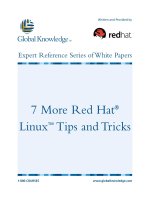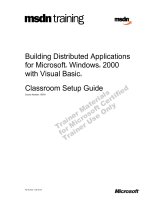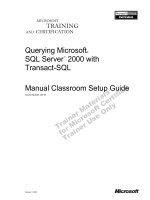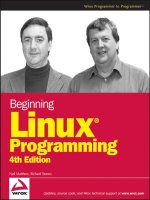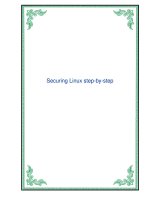Arch Linux Environment Setup How-to doc
Bạn đang xem bản rút gọn của tài liệu. Xem và tải ngay bản đầy đủ của tài liệu tại đây (3.87 MB, 68 trang )
www.it-ebooks.info
Arch Linux Environment
Setup How-to
Get started with Arch Linux as a blank canvas and build
the simple and elegant environment you want
Ike Devolder
BIRMINGHAM - MUMBAI
www.it-ebooks.info
Arch Linux Environment Setup How-to
Copyright © 2012 Packt Publishing
All rights reserved. No part of this book may be reproduced, stored in a retrieval system,
or transmitted in any form or by any means, without the prior written permission of the
publisher, except in the case of brief quotations embedded in critical articles or reviews.
Every effort has been made in the preparation of this book to ensure the accuracy of the
information presented. However, the information contained in this book is sold without
warranty, either express or implied. Neither the author, nor Packt Publishing, and its dealers
and distributors will be held liable for any damages caused or alleged to be caused directly
or indirectly by this book.
Packt Publishing has endeavored to provide trademark information about all of the
companies and products mentioned in this book by the appropriate use of capitals.
However, Packt Publishing cannot guarantee the accuracy of this information.
First published: November 2012
Production Reference: 1161112
Published by Packt Publishing Ltd.
Livery Place
35 Livery Street
Birmingham B3 2PB, UK.
ISBN 978-1-84951-972-4
www.packtpub.com
www.it-ebooks.info
Credits
Author
Ike Devolder
Reviewers
David Couzelis
Michael Driscoll
Acquisition Editor
Joanna Finchen
Commissioning Editors
Maria D'souza
Shreerang Deshpande
Technical Editor
Manmeet Singh Vasir
Copy Editor
Alda Paiva
Project Coordinator
Shraddha Bagadia
Proofreaders
Maria Gould
Aaron Nash
Production Coordinator
Prachali Bhiwandkar
Cover Work
Prachali Bhiwandkar
Cover Image
Aditi Gajjar
www.it-ebooks.info
About the Author
Ike Devolder started playing around with Linux in 1999 and became a full-time Linux user
in 2002. At that time his preferred distribution was Slackware, which he used for many years
without complaints. In 2005 he rediscovered Arch Linux (he had already played around with it
in the past) and started considering switching all his desktops from Slackware to Arch Linux.
In 2006 it was done, with his laptop and desktop both running smoothly on Arch Linux, and
since then he has gradually stopped being a distrohopper.
These days Ike is a Web Developer for Studio Emma in Belgium. He uses Arch Linux in his day
job too.
I would like to thank my wife for her patience, moral support, and love. I
would also like to thank the whole Arch Linux community for bringing us a
superb Linux distribution. In the end, I would like to thank my parents for
supporting me all the way in whatever choice I have ever made.
www.it-ebooks.info
About the Reviewers
David Couzelis is a professional Software Developer who fell in love with GNU/Linux over
a decade ago. As a hobby he makes video games, and hopes to someday make one that's
actually fun. He's also one of those free and open source software advocates, the type who
teaches people about software freedoms even if they didn't ask.
Michael Driscoll has been programming in Python since spring 2006. He enjoys writing
about Python on his blog at Mike also
occasionally writes for the Python Software Foundation (PSF), IProgrammer, and Developer
Zone. He enjoys photography and sitting down with a good book.
I would like to thank my wife, Evangeline, for always supporting me. I would
also like to thank my friends and family for all that they do to help me.
Lastly, I would like to thank Jesus Christ for saving me.
www.it-ebooks.info
www.PacktPub.com
Support les, eBooks, discount offers and more
You might want to visit www.PacktPub.com for support les and downloads related to
your book.
Did you know that Packt offers eBook versions of every book published, with PDF and ePub
les available? You can upgrade to the eBook version at
www.PacktPub.com and as a print
book customer, you are entitled to a discount on the eBook copy. Get in touch with us at
for more details.
At
www.PacktPub.com, you can also read a collection of free technical articles, sign up
for a range of free newsletters and receive exclusive discounts and offers on Packt books
and eBooks.
Do you need instant solutions to your IT questions? PacktLib is Packt's online digital book
library. Here, you can access, read and search across Packt's entire library of books.
Why Subscribe?
f Fully searchable across every book published by Packt
f Copy and paste, print and bookmark content
f On demand and accessible via web browser
Free Access for Packt account holders
If you have an account with Packt at www.PacktPub.com, you can use this to access
PacktLib today and view nine entirely free books. Simply use your login credentials for
immediate access.
www.it-ebooks.info
www.it-ebooks.info
www.it-ebooks.info
I would like to dedicate this book to my daughter Moyra.
www.it-ebooks.info
www.it-ebooks.info
Table of Contents
Preface 1
Arch Linux Environment Setup How-to 7
Installing Arch Linux using the ofcial ISO (Should know) 7
Installing Arch Linux using the Archboot ISO (Should know) 15
Conguring your system (Should know) 26
Installing and removing packages (Must know) 30
Booting and managing services with systemd (Should know) 39
Booting and managing services using initscripts (Should know) 42
Conguring GUI using Xorg (Should know) 45
www.it-ebooks.info
www.it-ebooks.info
Preface
Arch Linux is an independently developed, general purpose GNU/Linux distribution, optimized
for i686/x86-64 systems. The distribution is versatile enough to suit you in any role/need.
It has been designed focusing on simplicity, code elegance, and "do-it-yourself" principles.
The basic installation of Arch Linux is a very minimal base system. From the base system,
everything can and will be congured by the user to suit their ideal environment, suited for their
own unique purposes. The supported method of conguration is from the shell editing simple
text les. Being a rolling-release distribution, there are no xed releases. From time to time
there are new install images provided by the Release Engineering Team, so that the installation
media suits the new features introduced over time. Because of this rolling-release model, Arch
Linux provides you with bleeding-edge software, typically the latest stable versions available.
Pacman is the package manager of Arch Linux, which is designed to be an easy to use binary
package manager.
History
Arch Linux was founded in 2002 by Judd Vinet who was inspired by the elegance and
simplicity of some other Linux distributions such as Slackware, Polish Linux Distribution,
and CRUX. But this simplicity came without a package manager, which was a big
disappointment. Basically, to make his own life easier, Judd Vinet started Arch Linux with
pacman as the package manager that can automatically handle the installation, upgrade,
or removal of packages. Over the years Arch Linux kept on gaining more users, more
developers, and has now been in the top 10 used distributions on DistroWatch for a pretty
long time. Arch Linux is still being developed by volunteers and is not backed by some big
company; the goal is to stay free in every sense of the word. In 2007 Judd Vinet passed the
Project Lead to Aaron Grifn, who remains the Lead Arch Linux Developer to this day.
The Arch Way
The Arch Linux philosophy, also described as "The Arch Way", is in general summarized as being
KISS (keep it simple stupid). There are ve core principles dened in this core: philosophy,
simplicity, code-correctness over convenience, user-centric, openness, and freedom.
www.it-ebooks.info
Preface
2
Simplicity is denitely the base objective for Arch development, with the idea that a lightweight
base structure with high quality code will have lower system resource demands. The base
system found in Arch Linux has no clutter that might hide parts of the system, or make it difcult
to access parts of the system. All conguration les are simple, nicely documented, easy to read,
and nicely arranged for quick editing. There are no special conguration tools that might hide
possibilities from the user, which leads to a system congurable to the very last detail. The Arch
Linux Developers believe that trying to hide the complexity of a system results in an even more
complex system, and this should always be avoided.
Arch Linux denes simplicity as without unnecessary additions, modications,
or complications, and provides a lightweight UNIX-like base structure that allows
an individual user to shape the system according to their own needs. In short: an
elegant, minimalist approach.
Code-correctness over convenience implies clean, correct, simple code and not unneeded
patching, automation, eye candy or "newbie-friendliness". Software patches are only
introduced when needed. Packages found in Arch Linux are really the way the Developers
created them, nothing more, nothing less.
Simplicity of implementation, code-elegance, and minimalism shall always remain
the reigning priorities of Arch development.
Being user-centric means that the users fully manage the system on their own. The system
will offer no, to little assistance. There is a simple set of maintenance tools that are simply
relaying the commands given by the user. Arch Linux is founded on simple, sensible design,
and excellent documentation. As a user, you need more of a "do-it-yourself" approach rather
than asking the Developers to implement a new feature. Most Arch users have indeed the
tendency to solve their problems and share them with the entire community, which also
leads to a friendly and helpful community of developers and users.
Arch Linux targets and accommodates competent GNU/Linux users by giving them
complete control and responsibility over the system.
Openness is also briey touched upon in the just discussed principle, saying most Arch users
share the solutions to the problems they have encountered. Also, the Arch Linux Developers
strive for an open system, which goes hand in hand with simplicity. Openness is intended to
make things simple. It also removes the abstraction of things, which might lead to a steeper
learning curve, but in the end it leads to an easily controllable and maintainable system.
More experienced Arch users nd some of the helper tools provided by other distributions
cumbersome, and things that are sitting in the way of easy and fast conguration. The Arch
Linux community is also known to be very open and willing to give advice.
Arch Linux uses simple tools, that are selected or built with openness of the
sources and their output in mind.
www.it-ebooks.info
Preface
3
Freedom is probably one of the most important things you get when you start using a
Linux-based operating system. This is where Arch Linux is one of the leading distributions
where all congurations and decisions regarding the system are taken by the user. In the
end, the user denes the system. Arch Linux is built in such a way that you can—if you really
want to—rebuild the entire system. It even provides a simple tool to do so. The entire system
and all of the components are 100 percent transparent, so you can replace everything with
something else providing the same functionality. In addition to this, Arch Linux also provides
the freedom to use exclusively open source software, but you can also without hassle use
proprietary software packages.
By keeping the system simple, Arch Linux provides the freedom to make any choice
about the system.
Ending with a nal quote from Judd Vinet:
[Arch Linux] is what you make it.
Bleeding edge
Arch Linux strives to maintain and have the latest and greatest software available in its
repositories. Being a rolling-release distribution, it allows a one-time install with continuous
updates without ever having to reinstall or having to go to massive procedures for getting the
system upgraded. The goal of bleeding edge is also to provide for the newest features popping
up in the Linux world—be it in the eld of lesystems (ext4, ReiserFS, XFS, JFS, Btrfs, NILFS,
and so on), software RAID, or boot scripts (systemd)—along with supporting the latest features
of the newest hardware because of the immediate availability of the newest kernels.
What this book covers
Installing Arch Linux using the ofcial ISO (Should know), explains the procedure to get Arch
Linux installed on your system using the ofcial installation media.
Installing Arch Linux using the Archboot ISO (Should know), explains the procedure to get
Arch Linux installed on your system using the Archboot installation media.
Conguring your system (Should know), explains where to set your hostname, load special
modules, and have a different keyboard layout than QUERTY.
Installing and removing packages (Must know), explains how to use the package manager
(pacman) for adding and removing packages.
Booting and managing services with systemd (Should know), explains conguring and
managing how your system starts up and what services are being started automatically,
but using systemd and not sysvinit.
www.it-ebooks.info
Preface
4
Booting and managing services using initscripts (Should know), explains conguring and
managing how your system starts up and what services are being started automatically
using initscripts.
Conguring GUI using Xorg (Should know), briey explains how to get your GUI up and running.
What you need for this book
In general when reading this book, we assume you already have a basic knowledge of how
to install and use a Linux distribution such as Ubutnu, openSUSE, Fedora, and so on.
Arch Linux in general aims at more experienced users and also users with a big
"do-it-yourself" mentality.
Who this book is for
For those who love free software and want to use a super-customizable Linux distribution, all
those wanting the latest software when it is released, and everyone wanting to end up with a
system customized to their needs and wishes, Arch Linux is the way to go.
Conventions
In this book, you will nd a number of styles of text that distinguish between different kinds of
information. Here are some examples of these styles, and an explanation of their meaning.
Code words in text are shown as follows: "Add the
nomodeset parameter to the kernel
command line to make sure that the open source drivers will not kick in."
A block of code is set as follows:
Section "InputClass"
Identifier "evdev keyboard catchall"
MatchIsKeyboard "on"
MatchDevicePath "/dev/input/event*"
Driver "evdev"
Option "XkbModel" "pc105"
Option "XkbLayout" "be"
EndSection
When we wish to draw your attention to a particular part of a code block, the relevant lines or
items are set in bold:
DAEMONS=(syslog-ng !network crond)
www.it-ebooks.info
Preface
5
Any command-line input or output is written as follows:
systemctl list-units type=service
systemctl list-units -a type=service
New terms and important words are shown in bold. Words that you see on the screen, in
menus or dialog boxes for example, appear in the text like this: "The Auto-Prepare option
will guide you with the creation for a default partition scheme."
Warnings or important notes appear in a box like this.
Reader feedback
Feedback from our readers is always welcome. Let us know what you think about this
book—what you liked or may have disliked. Reader feedback is important for us to develop
titles that you really get the most out of.
To send us general feedback, simply send an e-mail to
, and
mention the book title through the subject of your message.
If there is a topic that you have expertise in and you are interested in either writing or
contributing to a book, see our author guide on www.packtpub.com/authors.
Customer support
Now that you are the proud owner of a Packt book, we have a number of things to help you
to get the most from your purchase.
Errata
Although we have taken every care to ensure the accuracy of our content, mistakes do
happen. If you nd a mistake in one of our books—maybe a mistake in the text or the
code—we would be grateful if you would report this to us. By doing so, you can save other
readers from frustration and help us improve subsequent versions of this book. If you
nd any errata, please report them by visiting
selecting your book, clicking on the errata submission form link, and entering the details
of your errata. Once your errata are veried, your submission will be accepted and the
errata will be uploaded to our website, or added to any list of existing errata, under the
Errata section of that title.
www.it-ebooks.info
Preface
6
Piracy
Piracy of copyright material on the Internet is an ongoing problem across all media. At Packt,
we take the protection of our copyright and licenses very seriously. If you come across any
illegal copies of our works, in any form, on the Internet, please provide us with the location
address or website name immediately so that we can pursue a remedy.
Please contact us at with a link to the suspected pirated material.
We appreciate your help in protecting our authors, and our ability to bring you valuable content.
Questions
You can contact us at if you are having a problem with any
aspect of the book, and we will do our best to address it.
www.it-ebooks.info
Arch Linux Environment
Setup How-to
Welcome to Arch Linux Environment Setup How-to. Arch Linux is a very exible distribution and
this book will guide you to the point where you can get a basic system in place. From there on
you can go in any direction you want. A simple server, a full-blown desktop system with all the
bells and whistles. In the end, Arch Linux is always what you make of it.
Installing Arch Linux using the ofcial ISO
(Should know)
These days the installation of Arch Linux might look like a work of insanity, as there is no
installer available in the ofcial media, just a guideline to follow. The installation without an
installer is as easy as it can be. For experienced users, installing without an installer is even
more convenient. The newest ISOs require that you have your machine connected to the
Internet, as there are no longer packages available on the installation media.
Getting ready
You can get the ofcial ISO image le from
On this page you will nd a download link to the latest release. Depending on your preference,
download the torrent le or the ISO image le immediately.
www.it-ebooks.info
Arch Linux Environment Setup How-to
8
The following list describes the main tasks that we will perform in this recipe:
f Preparing, booting, and setting keyboard layout: We are going to get the ISO le from
the download page of the Arch Linux website and store it on the preferred media of
our choice. At the time of writing this book, there is a dual ISO image le that contains
both i686 and x86-64 architectures on one disk. Start your PC with your preferred
installation media (CD or USB stick). On most PC systems, you can access the boot
menu by pressing one of the function keys, usually between F8 and F12 depending on
the motherboard manufacturer. On older machines where you do not yet have a boot
menu, you might need to change the boot order in the BIOS where the CD-ROM (or
DVD/Blu-ray) has to be chosen as the rst device to try booting from. We'll also explain
how to use a different keyboard layout than the default one in this recipe.
f Creating, formatting, and mounting partitions: You can partition the disks the way
you want using cfdisk (for MBR disk partitioning) or cgdisk (for GUID disk partitioning).
After creating the partitions, we can choose to format our created partitions with
specic lesystems. When all partitions are formatted, we need to mount the
partitions. First we will mount the root partition to /mnt. The other partitions will
be mounted later on after you have created the specic folders. We'll designate our
device with /dev/sdX; in your case this can be /dev/sda, and so on.
f Connecting to the Internet: To be able to continue installing the ISO you need to
connect to the Internet, because there are no packages available for installation on
the ISO. For a wireless network you will need to use netcfg. When connected to a
wired network, just use dhcpcd or dhclient.
f Installing the base system and boot loader: These days the base system gets
installed by running a simple script pacstrap. Pacstrap takes multiple parameters,
the target location, and the packages or groups you want to install. For people who
want to develop on their machines, the best base install is adding base-devel to
the default installation. For normal end users, just base will be sufcient to start.
f Conguring the system: In this recipe, we'll describe the ow of what to do during the
conguration. For more extensive information on how to congure your system, refer
to the Conguring your system recipe.
www.it-ebooks.info
Arch Linux Environment Setup How-to
9
How to do it
The following steps will guide you in preparing, booting, and setting keyboard layout:
1. Once you have downloaded the ISO image le, you should also verify its integrity by
downloading the
sha1sums.txt le from the download page.
These days you can also check if the ISO is completely valid
by verifying the signature of the ISO.
2. Verify the integrity by issuing the sha1sum -c sha1sums.txt command and you'll
see whether your download was successful or not. Also check if the signature of the
ISO is correct by running gpg -v archlinux iso.sig:
sha1sum -c sha1sums.txt
gpg -v archlinux-2012-08-04-dual.iso.sig
The following screenshot shows the execution of this step:
3. As you can see in the previous screenshot, the ISO's checksum is ok and the
signature is valid.
4. Now that we are sure our ISO is ok, we can burn this to a CD with our favorite
burning program.
5. Insert the CD into the drive, or insert the USB stick into the USB port of your PC.
6. Enter the boot menu, or let your computer automatically boot from the inserted
installation media.
www.it-ebooks.info
Arch Linux Environment Setup How-to
10
7. If the previous steps are performed correctly, you will see the following screenshot:
8. Select the architecture you want and press Enter, and we'll be on our way.
9. Search the keyboard layout desired for your region. The available keyboard layouts
can be found at /usr/share/kbd/keymaps/.
10. Set the desired keyboard layout with loadkeys keyboardlayout.
Now let's perform the following steps to create, format, and mount partitions:
1. Start cfdisk or cgdisk, having the rst parameter as the device you want to partition:
cfdisk /dev/sdX
cgdisk /dev/sdX
2. Create your partition scheme.
3. Store the partition scheme.
4. Use the mkfs command to create a lesystem on a specic partition:
mkfs -t vfat /dev/sdX
mkfs.ext4 -L root /dev/sdX
5. Mount your root partition to /mnt:
mount /dev/sdX3 /mnt
www.it-ebooks.info
Arch Linux Environment Setup How-to
11
6. Make directories under mount for your other partitions:
mkdir -p /mnt/boot
7. Mount the other partitions:
mount /dev/sdX1 /mnt/boot
The following steps are needed to connect to the Internet:
1. When we need a wireless network, create a netcfg prole and run netcfg
mywireless
.
2. Use dhclient or dhcpcd to get an IP address.
The following steps should be performed for installing the base system and boot loader:
1. Run pacstrap with the desired parameters:
pacstrap /mnt base base-devel
2. Install the desired boot loader: the best choice at this moment is Syslinux.
3. The nal installation of the boot loader will be done in a chroot during the initial
conguration (discussed later in the book).
We'll now list the steps to do during the conguration:
1. Generate
fstab with genfstab:
genfstab -p /mnt >> /mnt/etc/fstab
2. Change the root into the system location:
arch-chroot /mnt
3. Set your hostname in /etc/hostname.
4. Create
/etc/localtime symlink.
5. Set your locale in /etc/locale.conf.
6. Uncomment the congured locale in /etc/locale.gen.
7. Run
locale-gen.
8. Congure
/etc/mkinitcpio.conf.
9. Generate your initial ramdisk:
mkinitcpio -p linux
10. Finish installation of your boot loader.
11. Set the root password with
passwd.
www.it-ebooks.info
Arch Linux Environment Setup How-to
12
12. Leave the chroot environment (exit).
For more extensive information on how to configure your system,
refer to the Configuring your system recipe.
For a detailed description of the main tasks performed, refer to
the Getting ready section of this recipe.
How it works
We downloaded the ISO image le via torrent, or via HTTP from the mirror sites listed on the
download page. The sha1sum command lets us verify the integrity of the downloaded ISO.
On top of the checksum, we can also check the integrity by verifying the signature available
for the ISO. So now, we can rest assured that the downloaded le is the real one. The ISO
contains a fully working operating system. It also contains all the necessary tools to perform
system recovery and installation.
The keyboard conguration set with loadkeys will make sure that the key you press on your
keyboard will be translated to the correct letter on your screen. Using a different keyboard
layout from the one on your physical keyboard might be confusing.
We then created a partition scheme on the selected disk with the appropriate tool (cfdisk
or cgdisk). Make Filesystem (mkfs) is a unied frontend to create a lesystem. Using it we
created our lesystem layout manually under
/mnt by creating our default partition layout
in our root, and mounting the specic partitions accordingly.
You can make a connection with your wireless network (if needed), and then use dhcpcd or
dhclient to obtain an IP address that enables you to access the Internet.
Pacstrap will run pacman with a modied root location to install the desired packages into
the newly created system.
For example, installing Syslinux:
pacstrap /mnt syslinux
The specic conguration les will ensure we don't have to do all those steps over and over
again on every boot.
There's more
You can use the ofcial ISO directly from the USB stick if you prefer. There might be some
issues with the verication of the ISO. The next two sections discuss them and provide you
with the solution.
www.it-ebooks.info




